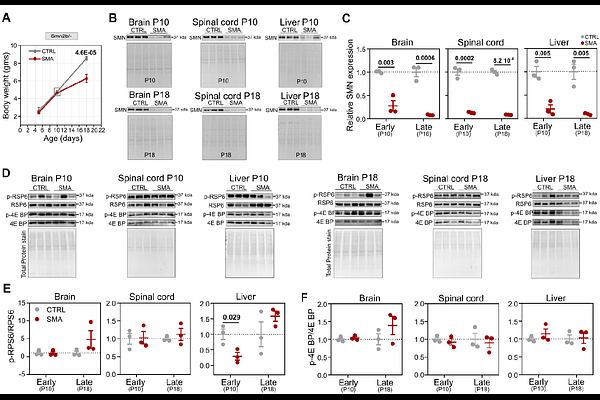Translation-specific disruption of Col1a1 expression in multiple models of Spinal Muscular Atrophy can be rescued by Risdiplam.

Translation-specific disruption of Col1a1 expression in multiple models of Spinal Muscular Atrophy can be rescued by Risdiplam.
Sharma, G.; Paganin, M.; Huang, N.; Perenthaler, E.; Signoria, I.; Faller, K.; Maniscalco, F.; Perrucci, C.; Donzel, D.; Chaytow, H.; Basso, M.; Lauria, F.; Kothary, R.; Van Der Pol, L.; Claus, P.; Groen, E. J.; Gillingwater, T. H.; Viero, G.
AbstractSpinal muscular atrophy (SMA) is a monogenic neurodegenerative disorder caused by decreased levels of Survival of Motor Neuron (SMN) protein. If left untreated, SMA patients have a poor prognosis, marked by the degeneration of motor neurons, progressive muscle weakness and atrophy. The approval of SMN-restoring therapies that improve symptoms and lifespan in patients with SMA has created emerging, non-neuronal phenotypes and an urgent need for deepening our understanding of disease pathogenesis. Leveraging the knowledge that SMN loss drives alterations in translation, we used multiple tissues from a mouse model of SMA to uncover early translational alterations in key mRNAs and proteins, which act as contributors to pathogenesis and hallmarks of the disease. Among hundreds of differentially translated mRNAs, Col1a1 emerged as a translation-specific manifestation of early defects in the mouse model. These findings were confirmed in fibroblasts derived from patients with varying levels of disease severity. Notably, treatment with SMN-restoring therapies rescued COL1A1 protein levels, particularly in fibroblasts from patients with the most severe forms of the disease. Overall, our study identifies COL1A1 as an indicator of disease severity in SMA, which captures early molecular alterations and respond to SMN-modifying therapies.